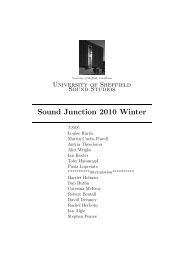Compositional Methods in Electroacoustic Music - Adrian Moore ...
Compositional Methods in Electroacoustic Music - Adrian Moore ...
Compositional Methods in Electroacoustic Music - Adrian Moore ...
Create successful ePaper yourself
Turn your PDF publications into a flip-book with our unique Google optimized e-Paper software.
Leeds College of <strong>Music</strong><br />
The Tilt project was implemented with a view of creat<strong>in</strong>g music and visual <strong>in</strong>terpretations with three <strong>in</strong>dividual<br />
phases from a ‘collaborative’ perspective. The idea be<strong>in</strong>g that no contributor would have control of the<br />
others’ creative decisions and therefore have no control of the Tilt project other than their own creative decisions<br />
with<strong>in</strong> the composition process (performance; composition; visual <strong>in</strong>terpretation). The first piece to<br />
be produced was Tilt One for fixed medium and 5 octave Marimba; the second Tilt Zero, which is a stereo<br />
acousmatic piece. The f<strong>in</strong>al piece, Tilt Zero AV, is presented here; an audio-visual work.<br />
The Tilt project came out of the Leeds College of <strong>Music</strong> Postgraduate Studies and Research Centre. Contributors<br />
are Damien Harron (performer), Dale Jonathan Perk<strong>in</strong>s (composer) and Michael Brown (visual artist).<br />
Tilt Zero AV was produced <strong>in</strong> three phases; studio improvisations (performed by Damien Harron) us<strong>in</strong>g vibraphone,<br />
Kalimba and Rototom; the result<strong>in</strong>g sound materials were adopted, transformed, organised and<br />
structured by Dale Jonathan Perk<strong>in</strong>s; f<strong>in</strong>al stages were undertaken by Michael Brown (University of Derby)<br />
to produce and structure visual materials by <strong>in</strong>terpret<strong>in</strong>g the organisational and structural decisions that the<br />
f<strong>in</strong>al audio part presented.<br />
Tilt Zero AV is an audio-visual work with subtle symbiotic relationships. All stages were completed <strong>in</strong>dependently<br />
to produce this f<strong>in</strong>al piece <strong>in</strong> order to see how the other performed, structured and <strong>in</strong>terpreted the<br />
available materials.<br />
Tread<strong>in</strong>g<br />
Summers, Mark<br />
University of Sheffield<br />
Tread<strong>in</strong>g b<strong>in</strong>ds together a number of strands of my musical <strong>in</strong>terests. It is made up of a series of seven improvisations<br />
on a viola da gamba, each one follow<strong>in</strong>g the same structure but created <strong>in</strong> isolation, result<strong>in</strong>g <strong>in</strong><br />
separate parts that tread their own <strong>in</strong>dividual ways through the piece’s structure. These were then layered<br />
and mixed to create seven virtual <strong>in</strong>struments which are placed around the audience.<br />
The sounds that make up the improvisations are mostly attempts to apply a k<strong>in</strong>d of analogue process<strong>in</strong>g us<strong>in</strong>g<br />
the viola da gamba itself <strong>in</strong>stead of electronic means. The <strong>in</strong>strument was recorded dry, allow<strong>in</strong>g the piece<br />
to be shaped by the performance space.<br />
Culture Shock<br />
Rossiter, Louise<br />
<strong>Music</strong>, Technology, Innovation Research Centre, De Montfort University<br />
In October 2011, I was fortunate enough to be selected as a f<strong>in</strong>alist <strong>in</strong> the New Generation Composition Competition<br />
as part of Electronic <strong>Music</strong> Week <strong>in</strong> Shanghai, People’s Republic of Ch<strong>in</strong>a. I was even more fortunate<br />
to be able to attend the performance and the associated conference.<br />
The trip to Ch<strong>in</strong>a has been an absolute revelation to me. Although I had visited Asia before and have travelled<br />
extensively, I had my first experience of Culture Shock. I was quite overcome by the language barrier<br />
and by the way of life <strong>in</strong> general. Many th<strong>in</strong>gs were new to me: wet markets with live animals be<strong>in</strong>g bought<br />
and then slaughtered, mopeds everywhere, the most confus<strong>in</strong>g pedestrian cross<strong>in</strong>g system I have ever known.<br />
As well as experienc<strong>in</strong>g a ‘visual’ culture shock, I also feel that I suffered from an ‘aural’ culture shock. As<br />
part of my normal go<strong>in</strong>g abroad ritual, I took some basic record<strong>in</strong>g equipment, a microtrack recorder and<br />
some b<strong>in</strong>aural headphones. However, despite hav<strong>in</strong>g a written record of all the record<strong>in</strong>gs I made, some come<br />
to the foreground of my memory far more quickly than others, almost like they would <strong>in</strong> a dream. I would<br />
refer to these as Aural Landmarks or Earcons.<br />
One of the most beautiful and mesmeris<strong>in</strong>g th<strong>in</strong>gs I heard <strong>in</strong> Ch<strong>in</strong>a was the sound of a yangq<strong>in</strong> play<strong>in</strong>g the<br />
traditional tune Zi Zhu Diao (The Purple Bamboo). As such, it plays an important part <strong>in</strong> this piece.<br />
This piece attempts to address some of what I heard and felt dur<strong>in</strong>g my trip to Shanghai. In particular, my<br />
culture shock and the effect it had on my memories of the trip and my associations of sounds. It is deliberately<br />
disjo<strong>in</strong>ted for this reason, as I want the listener to be forced <strong>in</strong>to the sound world that I have created.<br />
29



